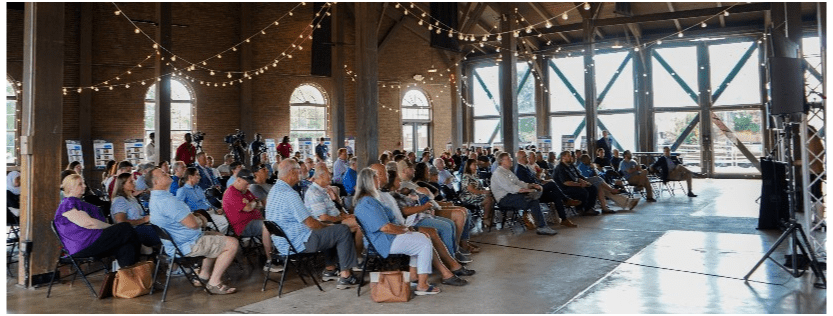Depot planning underway as City reimagines historic grounds as community hub
The Huntsville Depot won’t see a wrecking ball. The nearby Roundhouse isn’t a sure thing. Other buildings sharing the seven-acre site downtown off Church St. might get the axe.
The trio of Mayor Tommy Battle, Director of Urban and Long-Range Planning Dennis Madsen and City Historic Preservationist Katie Stamps have made assurances that while some buildings on the property might go, the Depot is safe.
What will eventually be done with the entire site is yet to be determined. The city held an online survey and received over 1,500 responses on what to put there. Last week, the first two of public input meetings were held at the Roundhouse with more scheduled for later.
“We are not tearing down the Depot,’’ Battle told the crowd gathered at the Roundhouse to discuss master plans. “We are not having any conversation about it.’’
Written across the top page of notes Madsen had was simply, “Preserve the Depot.’’
“I’m gonna hammer home what the mayor said,’’ he added. “Katie’s gonna hammer it home. I’m gonna hammer it home again. The Depot is not going anywhere.’’
There was really no rush to knock the building down to start with since it’s protected by a commitment Huntsville made with the Alabama Historical Commission that protects the Depot.
The Depot was built in 1860 and served a key rail route for the Confederacy during the Civil War. Union troops occupied the Depot in 1862 where they held some prisoners whose names are still scratched on the third-floor wall. Union personnel also occupied local homes and other facilities.
The Depot is listed on the National Register of Historic Places (1971) and the Alabama Register of Landmarks and Heritage (2002).
“We’re here to talk about one of Huntsville’s most significant historical places, the Huntsville Depot,’’ Battle said. “Not just to look back on a hundred and sixty sixty five years of great service that we’ve got now with that facility, but to imagine what the next hundred and sixty five years will be like.’’
The three-story Depot is about 10,500-square feet and the Roundhouse, which has most recently been used as an events venue, adds 10,400. The other buildings on the property have no historical value.
The occupation by Northern troops gave the Depot, one of the oldest in the country, its lasting fame.
“Around 200 Confederate soldiers had been captured, and they were confined within the Depot in kind of a makeshift jail,’’ Stamps said. “Two of those individuals made their escape, but the rest were mostly sent to Ohio. But what they left behind was graffiti on the walls that they drew.
“And so there were prayers, names, drawings that you will be able to see. They’re currently behind protective plexiglass. So those are still visible on the walls. You can see some of it on the second floor as you’re going up the stairs, and then the majority of (the graffiti) is on display on the Third Floor.’’
The city officials said they heard some interesting suggestions through the survey. However, there are environmental restrictions because the property is in a flood plain.
It could serve as a greenspace hub with routes connecting to Big Spring Park, the Veterans Memorial and Gateway Park. When the North Huntsville Greenway is complete there will be a greenway trail from Alabama A&M to Ditto Landing.
One thing the buildings and land won’t be used for is apartments. The city has studied other older railroad redevelopments for inspiration and has found a range of possibilities—restaurants, cafés, a drama workshop, and more. The options facing Huntsville seem almost limitless.
Michigan Central Station is now the centerpiece for Ford’s City of Tomorrow. There are retail spaces, plazas, commercial public space, and according to Madsen it’s become “kind of a tech and cultural hub that focuses on autonomous vehicle technology, sustainable transportation and mobility innovation.”
According to Battle, the process for developing a master plan is in the early stages and urged residents to keep suggestions coming. One surveyor suggested mini-golf.
“This seven-acre site, including the Depot, the Roundhouse, and the surrounding grounds has long been part of Huntsville’s story,’’ Battle said. “Now we have a rare opportunity to write the next chapter of that story.’’















